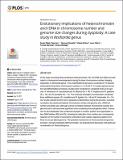Por favor, use este identificador para citar o enlazar a este item:
http://hdl.handle.net/10261/154536COMPARTIR / EXPORTAR:
 SHARE SHARE
 CORE
BASE CORE
BASE
|
|
| Visualizar otros formatos: MARC | Dublin Core | RDF | ORE | MODS | METS | DIDL | DATACITE | |

| Título: | Evolutionary implications of heterochromatin and rDNA in chromosome number and genome size changes during dysploidy: A case study in Reichardia genus |
Autor: | Siljak-Yakovlev, S.; Godelle, Bernard; Zoldos, Vlatka; Vallès, Joan CSIC ORCID; Garnatje, Teresa CSIC ORCID ; Hidalgo, Oriane CSIC ORCID | Fecha de publicación: | 9-ago-2017 | Citación: | PLoS ONE 12(8): e0182318 (2017) | Resumen: | In this study we showed that constitutive heterochromatin, GC-rich DNA and rDNA are implicated in chromosomal rearrangements during the basic chromosome number changing (dysploidy) in Reichardia genus. This small Mediterranean genus comprises 8–10 species and presents three basic chromosome numbers (x = 9, 8 and 7). To assess genome evolution and differentiation processes, studies were conducted in a dysploid series of six species: R. dichotoma, R. macrophylla and R. albanica (2n = 18), R. tingitana and R. gaditana (2n = 16), and R. picroides (2n = 14). The molecular phylogeny reconstruction comprised three additional species (R. crystallina and R. ligulata, 2n = 16 and R. intermedia, 2n = 14). Our results indicate that the way of dysploidy is descending. During this process, a positive correlation was observed between chromosome number and genome size, rDNA loci number and pollen size, although only the correlation between chromosome number and genome size is still recovered significant once considering the phylogenetic effect. Fluorescent in situ hybridisation also evidenced changes in number, position and organisation of two rDNA families (35S and 5S), including the reduction of loci number and, consequently, reduction in the number of secondary constrictions and nuclear organising regions from three to one per diploid genome. The potential mechanisms of chromosomal and genome evolution, strongly implicating heterochromatin, are proposed and discussed, with particular consideration for Reichardia genus. | Descripción: | 21 p., tablas, figuras -- Este es un artículo de acceso abierto distribuido bajos los términos de la licencia Atribución Internacional 4.0 (CC BY 4.0) de Creative Commons: https://creativecommons.org/licenses/by/4.0/ | Versión del editor: | https://doi.org/10.1371/journal.pone.0182318 | URI: | http://hdl.handle.net/10261/154536 | DOI: | 10.1371/journal.pone.0182318 | E-ISSN: | 1932-6203 |
| Aparece en las colecciones: | (IBB) Artículos |
Ficheros en este ítem:
| Fichero | Descripción | Tamaño | Formato | |
|---|---|---|---|---|
| Evolutionary_implications-Garnatje-2017.pdf | 5,92 MB | Adobe PDF |  Visualizar/Abrir |
CORE Recommender
PubMed Central
Citations
9
checked on 21-abr-2024
SCOPUSTM
Citations
26
checked on 19-abr-2024
WEB OF SCIENCETM
Citations
23
checked on 29-feb-2024
Page view(s)
340
checked on 21-abr-2024
Download(s)
293
checked on 21-abr-2024

